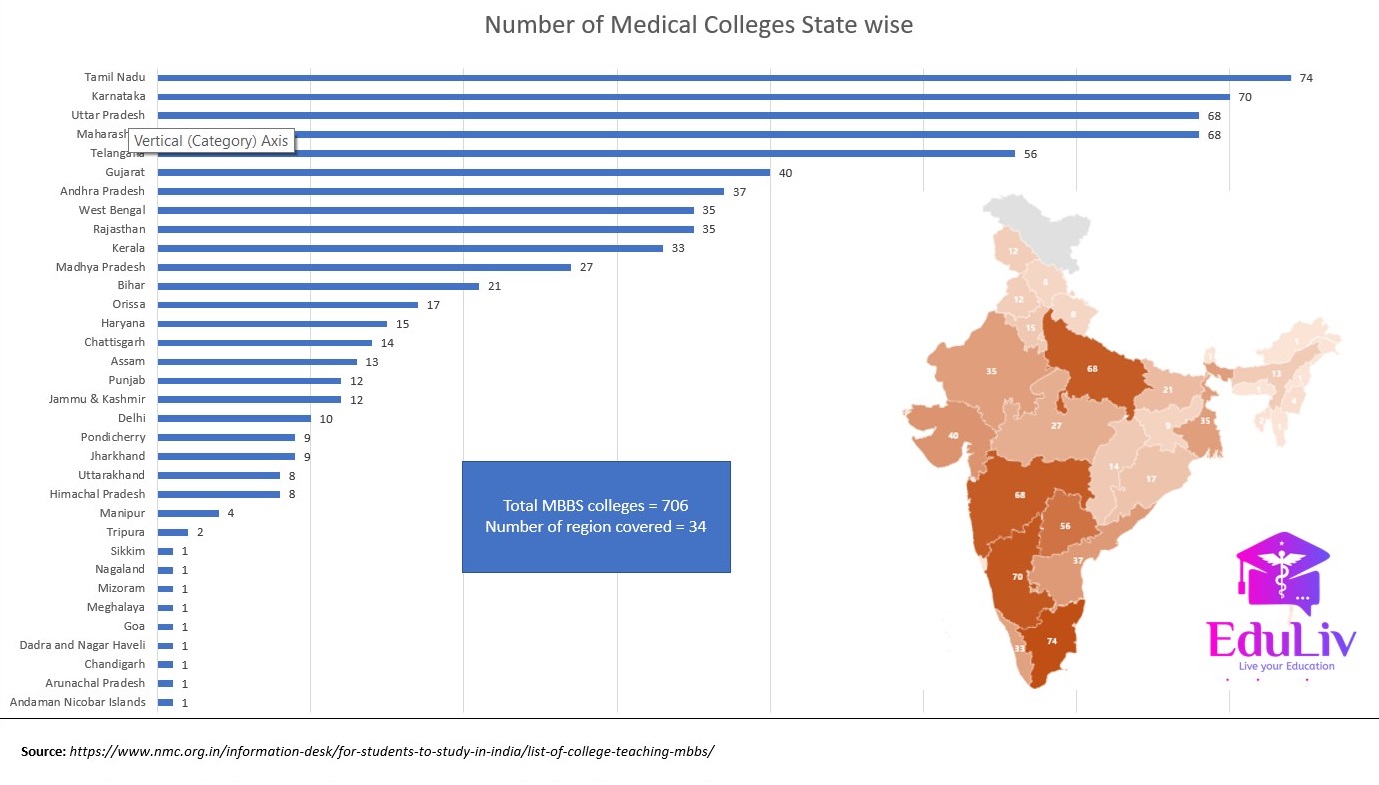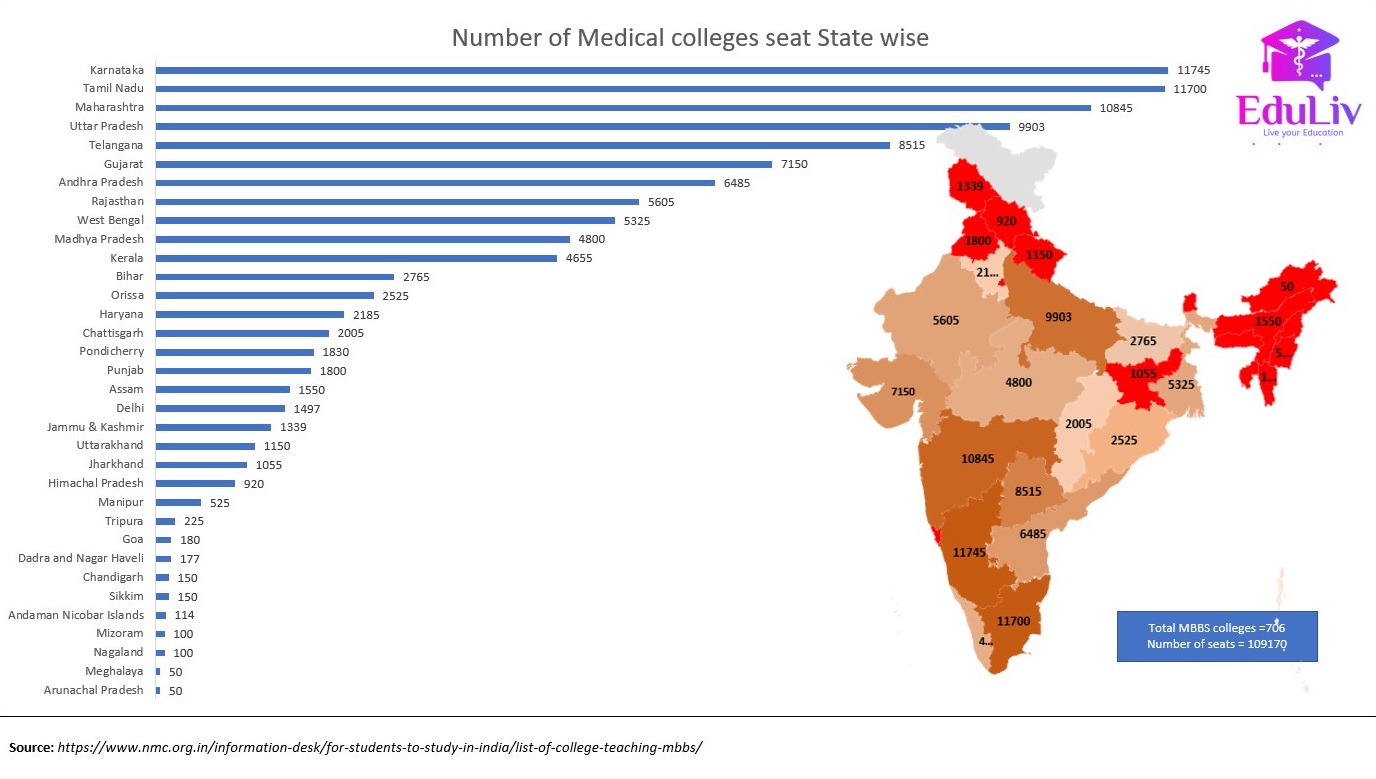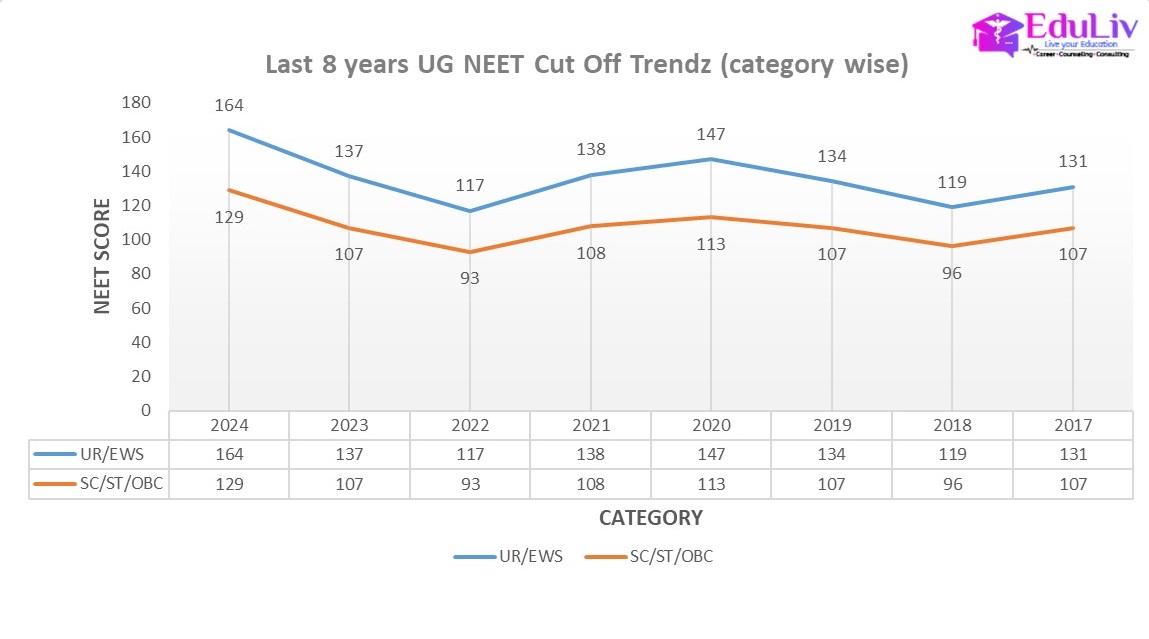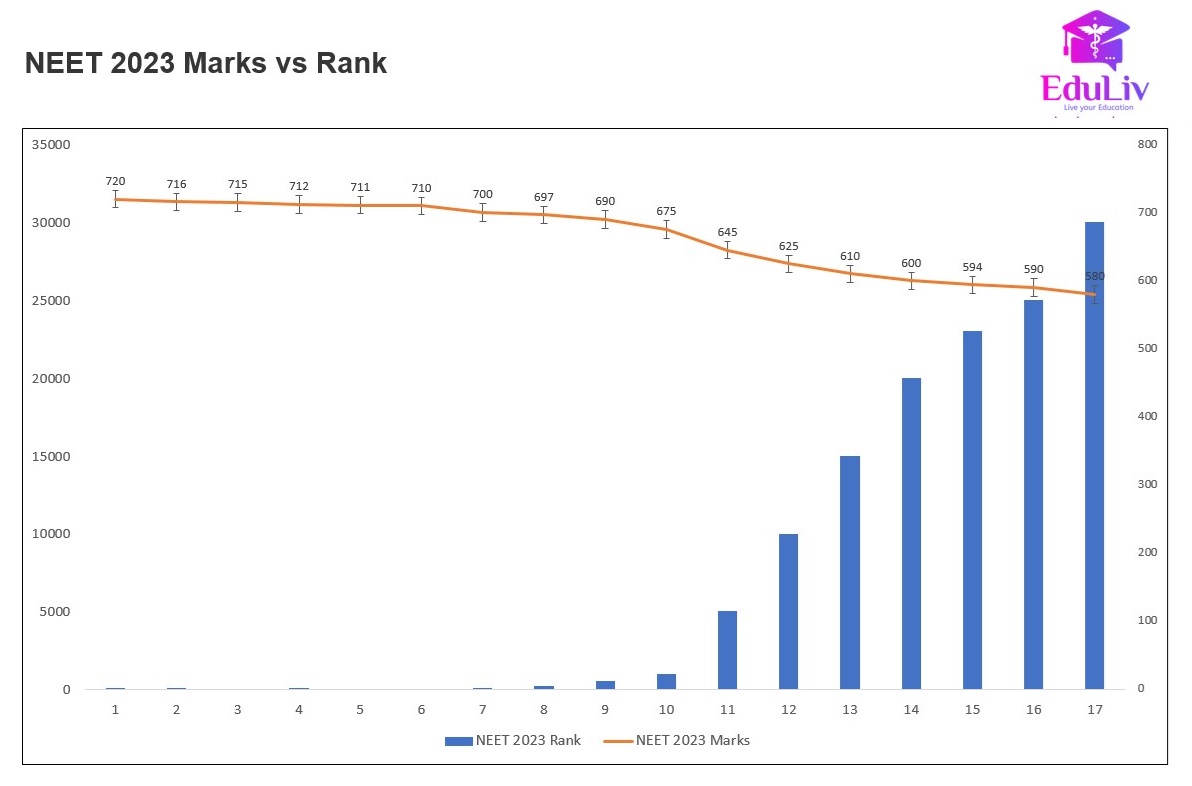
We are happy to provide an analysis of the data in the image. Here’s a narrative
At the pinnacle of this educational landscape, we find Tamil Nadu, Karnataka, boasting a remarkable count of 74, 70 medical colleges. It stands as a beacon of medical education, closely followed by Uttar Pradesh, Maharashtra, which houses 68 institutions dedicated to the medical field. These four-state account to 40% of the total colleges in India
Not far behind, Kerala, Rajasthan, West Bengal, Andhra Pradesh, Gujarat, Telangana making their mark with total of 33% medical colleges respectively. These six states, towering above the rest, serve as the epicentres of medical education in India.
However, as we traverse towards the other end of the spectrum, we encounter states where the medical education infrastructure seems sparse. States like Meghalaya, Mizoram, Nagaland, Sikkim, and Tripura each host a solitary medical college. The stark contrast between these states and the ones at the top is a testament to the disparities that exist in the distribution of educational resources.
This tale of numbers and bars is more than just a data visualization. It’s a mirror reflecting the state of medical education in India, highlighting areas of abundance and those in need of attention.
Let delve deeper into the data:
1. Regional Variance: The data clearly shows a significant variance in the distribution of medical colleges across different states. The southern and western states like Karnataka, Maharashtra, Tamil Nadu, and Gujarat have a higher number of medical colleges compared to the northeastern states like Meghalaya, Mizoram, Nagaland, Sikkim, and Tripura. This could be due to various factors such as population, state GDP, government policies, and infrastructure.
2. Urban vs Rural Divide: Although the data doesn’t explicitly show this, it’s common knowledge that most medical colleges are located in urban areas. This could lead to a rural-urban divide in access to medical education, which is a concern for equitable education opportunities.
3. Opportunities for Improvement: States with fewer medical colleges could be seen as potential areas to improve the availability of medical education.
4. Impact on Healthcare: The distribution of medical colleges can have a direct impact on the healthcare system of the states. States with more medical colleges can potentially have more healthcare professionals, which could lead to better healthcare services.
At the pinnacle of this educational landscape, we find Tamil Nadu, Karnataka, boasting a remarkable count of 74, 70 medical colleges. It stands as a beacon of medical education, closely followed by Uttar Pradesh, Maharashtra, which houses 68 institutions dedicated to the medical field. These four-state account to 40% of the total colleges in India
Not far behind, Kerala, Rajasthan, West Bengal, Andhra Pradesh, Gujarat, Telangana making their mark with total of 33% medical colleges respectively. These six states, towering above the rest, serve as the epicentres of medical education in India.
However, as we traverse towards the other end of the spectrum, we encounter states where the medical education infrastructure seems sparse. States like Meghalaya, Mizoram, Nagaland, Sikkim, and Tripura each host a solitary medical college. The stark contrast between these states and the ones at the top is a testament to the disparities that exist in the distribution of educational resources.
This tale of numbers and bars is more than just a data visualization. It’s a mirror reflecting the state of medical education in India, highlighting areas of abundance and those in need of attention.
Let delve deeper into the data:
1. Regional Variance: The data clearly shows a significant variance in the distribution of medical colleges across different states. The southern and western states like Karnataka, Maharashtra, Tamil Nadu, and Gujarat have a higher number of medical colleges compared to the northeastern states like Meghalaya, Mizoram, Nagaland, Sikkim, and Tripura. This could be due to various factors such as population, state GDP, government policies, and infrastructure.
2. Urban vs Rural Divide: Although the data doesn’t explicitly show this, it’s common knowledge that most medical colleges are located in urban areas. This could lead to a rural-urban divide in access to medical education, which is a concern for equitable education opportunities.
3. Opportunities for Improvement: States with fewer medical colleges could be seen as potential areas to improve the availability of medical education.
4. Impact on Healthcare: The distribution of medical colleges can have a direct impact on the healthcare system of the states. States with more medical colleges can potentially have more healthcare professionals, which could lead to better healthcare services.

The Government, standing tall with a count of 379 medical colleges. It plays a pivotal role in shaping the medical education landscape of India, providing the majority of the educational infrastructure in this sector.
Following the government, we find the Trusts, supporting 258 medical colleges. They form a significant part of the narrative, contributing to the diversity of the educational landscape.
As we move further, the presence of Societies comes into view, backing 38 medical colleges. Their role, although smaller compared to the Government and Trusts, is still crucial in the grand scheme of things.
The Private sector makes its appearance with 21 medical colleges. Despite being a smaller player in this narrative, its presence signifies the role of private capital in supporting medical education.
Finally, we encounter a unique collaboration between the Government and Societies, jointly supporting 10 medical colleges. This partnership, although small in number, represents an innovative approach to backing educational institutions.
Let’s delve deeper into the data:
1. Government Dominance: The data clearly shows that the government plays a dominant role in backing medical colleges in India. This could be due to various factors such as government policies, public sector investment, and the importance of healthcare in public welfare.
2. Role of Trusts: Trusts also play a significant role in supporting medical colleges. These trusts could be philanthropic organizations or non-profit entities that aim to promote medical education. The significant number of colleges backed by trusts indicates the active involvement of non-governmental organizations in India’s healthcare education.
3. Private Sector Participation: The number of private medical colleges is relatively low. This could be due to regulatory challenges, high investment requirements, or other market dynamics. However, the presence of private colleges indicates the participation of private capital in the sector.
4. Collaborative Efforts: The chart shows a small number of colleges backed by a collaboration between the government and societies. This indicates an innovative approach to supporting medical education and could be an area for further exploration and development.
5. Policy Implications: The data can have significant policy implications. For instance, policymakers could use this information to encourage more private sector participation or promote collaborative efforts.
Following the government, we find the Trusts, supporting 258 medical colleges. They form a significant part of the narrative, contributing to the diversity of the educational landscape.
As we move further, the presence of Societies comes into view, backing 38 medical colleges. Their role, although smaller compared to the Government and Trusts, is still crucial in the grand scheme of things.
The Private sector makes its appearance with 21 medical colleges. Despite being a smaller player in this narrative, its presence signifies the role of private capital in supporting medical education.
Finally, we encounter a unique collaboration between the Government and Societies, jointly supporting 10 medical colleges. This partnership, although small in number, represents an innovative approach to backing educational institutions.
Let’s delve deeper into the data:
1. Government Dominance: The data clearly shows that the government plays a dominant role in backing medical colleges in India. This could be due to various factors such as government policies, public sector investment, and the importance of healthcare in public welfare.
2. Role of Trusts: Trusts also play a significant role in supporting medical colleges. These trusts could be philanthropic organizations or non-profit entities that aim to promote medical education. The significant number of colleges backed by trusts indicates the active involvement of non-governmental organizations in India’s healthcare education.
3. Private Sector Participation: The number of private medical colleges is relatively low. This could be due to regulatory challenges, high investment requirements, or other market dynamics. However, the presence of private colleges indicates the participation of private capital in the sector.
4. Collaborative Efforts: The chart shows a small number of colleges backed by a collaboration between the government and societies. This indicates an innovative approach to supporting medical education and could be an area for further exploration and development.
5. Policy Implications: The data can have significant policy implications. For instance, policymakers could use this information to encourage more private sector participation or promote collaborative efforts.

The Government, standing tall with a count of 54,580(50%) medical seats. It plays a pivotal role in shaping the medical education landscape of India, providing the majority of the educational infrastructure in this sector.
Following the government, we find the Trusts, supporting 43,715(40%) medical seats. They form a significant part of the narrative, contributing to the diversity of the educational landscape.
As we move further, the presence of Societies comes into view, backing 5,850(5%) medical seats. Their role, although smaller compared to the Government and Trusts, is still crucial in the grand scheme of things.
The Private sector makes its appearance with 3,200(3%) medical seats. Despite being a smaller player in this narrative, its presence signifies the role of private capital in supporting medical education.
Finally, we encounter a unique collaboration between the Government and Societies, jointly supporting 1,825(2%) medical seats. This partnership, although small in number, represents an innovative approach to backing educational institutions.
Following the government, we find the Trusts, supporting 43,715(40%) medical seats. They form a significant part of the narrative, contributing to the diversity of the educational landscape.
As we move further, the presence of Societies comes into view, backing 5,850(5%) medical seats. Their role, although smaller compared to the Government and Trusts, is still crucial in the grand scheme of things.
The Private sector makes its appearance with 3,200(3%) medical seats. Despite being a smaller player in this narrative, its presence signifies the role of private capital in supporting medical education.
Finally, we encounter a unique collaboration between the Government and Societies, jointly supporting 1,825(2%) medical seats. This partnership, although small in number, represents an innovative approach to backing educational institutions.












